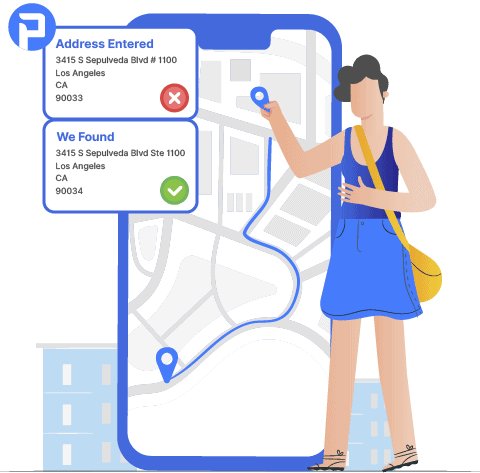What Is Postal Code and What Is Its Significance?
What Is Postal Code and What Is Its Significance?
If you have ever written a postal address, you know that there is a specific code mentioned in the end. But, what is meant by postal code? Such codes represent the geographic areas of addresses and help the concerned postal services deliver mail to them.

They can contain alphabets, numbers, or both. Courier companies and postal organizations use postal codes to sort their mail items in an automated way, speeding up delivery.
With increasing global trade and eCommerce, postal codes have become more important than ever. Hence, you should know what is postal code and how to use it.
Postal codes work differently in every country and they all have their own postal system. In this blog, we will talk about Canadian postal codes, what they represent, and how you can find your postal code.
Postal Codes in Canada
Canadian postal codes contain six characters and form an integral part of postal addresses in Canada. Similar to Dutch, British, and Irish postcodes, they are alphanumeric. These codes are divided into two parts with a space separating them. The format followed is A1A 1A1 with A being an alphabet and 1 being a number.
If you are wondering “what is my postal code Canada?” you can search it on Canada Post’s website and application for free. Or buy CD-ROMs and hard-copy directories at the post office.
Postal codes in Canada change at every block and are assigned to all street sides. Even two next-door neighbours might have different postal codes owing to this reason. Businesses that receive a lot of mail every day are likely to have their own postal codes. Hence, there are hundreds of thousands of postal codes all across Canada.
Canadian postal codes are often compared to ZIP codes in the US. They do the same job but there are a lot of differences. One US ZIP code covers around 100,000 mailing addresses. However, only a single Canadian postal code is assigned to one side of one street. It is why there are about 876,445 postal codes and only 41,692 ZIP codes.
The History of Canada Postal Codes
Introduction of Postal Zones
Numbered postal codes date back to 1925 when they were introduced in Toronto for the first time. For example, if you needed to mail to an address in zone 4, it was written in the below address format:
71 Edgemont Way South
Toronto 4, Ontario
In 1943, Toronto was segmented into 14 zones and numbered from 1 to 15. The numbers 7 and 11 remained unused. In 1944, Montreal also saw the implementation of postal zones.
Later, other Canadian cities were also split into postal zones, inclusive of Vancouver, Ottawa, Quebec, and Winnipeg. The addresses in these cities were also written with one-digit zone codes.
However, in the late 1960s, Canada Post introduced the three-digit code system replacing the earlier one-digit and two-digit zone codes. It was first implemented in major cities like Toronto, Vancouver, and Montreal.
Find below an example of an address in Vancouver with this new system:
862 Kinniburgh Blvd
Vancouver 106, Alberta
But, this three-digit zone number scheme was short-lived as Postmaster General Eric Kierans soon announced that they are cancelling it and introducing a new national postal code system.
Planning of the New Postal Code System
Canadian cities started growing in the 1950s and 1960s leading to a massive growth of the mail volume passing throughout the country. In no time, the volume grew from billions of mail items to tens of billions.
As a result, it became difficult for the postal services to hand-sort mail and remember all the carrier routes within cities. It added a lot of pressure on the employees to get the deliveries completed on time.
In 1969, the House of Commons discussed the potential impact of environmental change on Canada Post’s operations in the next 25 years. It was suggested that the post office should begin using automation and mechanization to deal with the growing mail volume and improve delivery efficiency. And that’s when the postal code design was first talked about.
Finally, Eric Keirancs announced the introduction of a six-digit postal code system in December 1969. This system completely replaced the three-digit zone number system. Later in February 1970, he tabled a report named “A Canadian Public Address Postal Coding System” put forward by Samson, Belair, Simpson, Riddell Inc.
Implementation
Before introducing the postal code system nationwide, it was first tested on 1st April 1974 in Ottawa. It was then accompanied by a provincial-level rollout in Manitoba.
The system was then gradually implemented in the remaining provinces and territories between 1972 and 1974. However, the use of this new system was still 38.2% by the time 1974 ended.
It helped Canada Post handle around 26,640 items per hour using sorting machines. The organization was now able to complete deliveries in less time and in a more efficient manner.
Eventually, companies also found it easier to complete orders on time and expand their operations.
But, the system got a strong pushback from the Canadian Union of Postal Workers. The reason was that workers who still sorted mail by hand received more wages than those who ran the automated mail machines.
The Union also declared a National “Boycott the Postal Code” Day on 20th March 1975 which did not go for long enough.
The boycott was struck off in 1976, and the Canadian postal code system was fully implemented in the country by then. It was among the last code systems to be implemented in the West.
Components of Canadian Postal Codes
Now that you know the history, it is important to understand its components. You can refer to the image below for a better understanding:

Forward Sortation Areas (FSAs)
FSAs make the first part of the Canadian postal code format. Basically, a forward sortation area is a region wherein all postal codes begin with the same three characters. For example, M4B in Toronto covers at least 600 geographical areas. All of these areas come under the same FSA.
The first character (an alphabet) of the FSA code indicates specific “postal districts,” which cover an entire province or territory. However, Quebec and Ontario are divided into several postal districts as they are large provinces.
Quebec has a total of three postal districts, while Ontario has five. Both of these provinces have at least one very populous urban area to have a dedicated postal district (“M” for Toronto and “H” for Montreal).
On the other hand, some places with low populations shared postal districts. For example, the Northwest Territories (NWT) and Nunavut continue to share the same postal district even after their separation in 1999.
Coming to the second character (a number) of the FSA, it primarily identifies areas as urban or rural. All rural regions have the number 0, whereas all other numbers denote urban regions.
The third character (an alphabet again), in combination with the other two characters, identifies a more accurate geographical district. It represents a section of a large metropolitan area, a medium-sized city, or a particular rural region.
Local Delivery Units (LDUs)
The last three characters of the postal code stand for an LDU which may denote a single address or a group of addresses.
An LDU can correspond to:
- Entire small towns
- Important areas of medium-sized towns
- Single sides of city blocks in large cities
- Single large buildings
- Parts of very large buildings
- Large institutions like hospitals and universities
- Businesses that receive large mail volumes regularly
As you can see, even single places or small units of these places can have LDU codes. So, it is not surprising that Canada has hundreds of thousands of LDUs.
The LDU code 9Z9 is exclusively assigned for Business Reply Mail. All LDU codes ending in zero are assigned to postal facilities including sortation plants, small post offices, and retail postal outlets.
Note that postal codes use only 20 alphabets; the alphabets D, F, I, O, Q, and U are never included.
Importance of Postal Codes in Canada
With the increase in global trade, postal codes are now more important than ever. The international logistics and shipping industry is completely dependent on mailing addresses with accurate postal codes.
Writing correct postal codes help the postal workers deliver your mail pieces without any delays, errors, or damages. It helps make the process more efficient and fast.
Using postal codes, a company director in UAE can send something to an investor in Canada or vice versa. Or, a Canadian company can expand its operations nationally. The point is that postal codes simplify mailing.
Postal codes are also used as social or demographic identifiers. They can differentiate between urban and rural areas.
This information can be used by decision-makers of various companies. Postal codes can help them make decisions like where to open a franchise or where to promote their services.
Without this knowledge, many businesses might end up making the wrong decisions like advertising in the wrong areas or opening a store where the population is very low.
Importance of Postal Codes in Canada
Postal codes are mainly important for mail items to reach the correct addresses. However, you need to write down other parts of mailing addresses correctly as well.
Find the postal address format as prescribed by Canada Post below:
For domestic addresses-
Jacob Mikaelson
16A Bay ST
Wolfville NS B4P 1L6
For international addresses-
Howard Doherty
770 Carnaby St
London, W1F 9PS
United Kingdom
As mentioned above, the name of the recipient always comes on the first line. If you are mailing to a business, add the company name on the second line.
Then, write the delivery address on the next line. This line consists of your apartment number and the street name. Don’t forget to include the street directions. Make sure to use the right abbreviations for words like street (ST), circle (CIR), and avenue (AVE).
The next line is also the last line of a Canadian postal address. Write the city name followed by the state abbreviation and the mailing postal code.
Note that there should be two spaces left between the state abbreviations and postal codes. For reference, find a list of the state abbreviations below:
| Province | Postal Abbreviations |
| Alberta | AB |
| British Columbia | BC |
| Manitoba | MB |
| New Brunswick | NB |
| Newfoundland and Labrador | NL |
| Nova Scotia | NS |
| Ontario | ON |
| Prince Edward Island | PE |
| Quebec | QC |
| Saskatchewan | SK |
| Northwest Territories | NT |
| Nunavut | NU |
| Yukon | YT |
As for international addresses, the only major difference is that you should write the country name on the last line.
Find below some additional Canada Post address guidelines to avoid surcharges and delays:
- Always write the street address in capital letters.
- Never put a hyphen between the FSA and LDU codes of a postal code. Also, use capital letters for the same.
- Don’t use punctuation marks unless for names like “St. Charles.”
- Write the return address in the same format as the mailing address and place it on the top-left corner of the envelope.
Urbanization of Rural Postal Codes
Canada Post uses the term “urbanization” to the process of converting rural postal codes into urban. As we discussed above, the second character of the code of rural areas is zero. In this process, this character is changed into another number.
The vacated postal code of the concerned rural area can be reassigned to another area or retired.
When the population of rural regions reaches a certain number, Canada Post decides to urbanize that region. There are several r factors other than the population that is considered while urbanizing areas.
For example, the postal code G0N 3M0 (assigned to Sainte-Catherine-de-la-Jacques-Cartier, Lac-Saint-Joseph, and Fossambault-Sur-le-Lac, Quebec) was urbanized in 2008 and changed to G3N 3M0.
Santa Claus
If you are discussing Canadian postal codes, talking about Santa Claus is a must. The tradition of writing letters to Santa Claus is quite famous in Canada, so much so that Canada Post decided to come up with an address for Santa.
In 1974, the Canada Post workers noticed that many letters were addressed to Santa Claus. Apparently, these letters were considered undeliverable.
Finally, Canada Post launched an official letter-response program for Santa Claus in 1983. By the end of 2011, 11,000 volunteers helped Canada Post handle all these letters across multiple locations in Canada.
Around 1,000,000 letters are written to Santa Claus each year, inclusive of some sent from outside Canada. All of these letters are answered by the volunteers in the same language they were written in.
A special mailing address was introduced for the same along with a unique postal code:
SANTA CLAUS
NORTH POLE H0H 0H0
CANADA
In french, it can be written as:
PÈRE NOËL
PÔLE NORD H0H 0H0
CANADA
The postal code H0H 0H0 has a special meaning. Firstly, it sounds like “HO HO HO” which is enough to give it the Christmas feel. The second character “0” stands for a rural delivery area and the “H” indicates the postal district of Montreal.
Canadian Forces Postal Services
Canada Post uses three special postal codes to convert civilian mail to mail handled by the Canadian Forces Postal Service.
All these three codes belong to the military post offices in Canada itself. Depending on the end destination, these codes are:
- B3K 5X5 (NS): the Fleet Mail Offices (FMO) in Halifax
- V9A 7N2 (BC): FMO in Victoria
- K8N 5W6 (ON): the Canadian Forces Post Office (CFPO) in Belleville
All of these postal codes represent a group of international military post offices, which are indicated by FMO or CPFO numbers instead of postal codes.
In this case, LDUs do not correspond to physical addresses, but rather represent virtual delivery units. This is because mail items are not delivered locally, but forwarded to the delivery units of Canadian military bases to ship abroad.
Find below an example:
Name of the Addressee
Slot #
PO Box 4829 Stn Forces
Victoria BC V9A 7N2
CANADA
In the above example, the postal services will deliver the mail to FMO in Victoria. Then, the Canadian Forces Postal System will further deliver it to the recipient at FMO 4829. All such deliveries are completed as per the timing and means as deemed fit by the military.
Difference Between ZIP Codes and Postal Codes
ZIP is the abbreviation of Zone Improvement Plan. In 1963, the US introduced the concept of ZIP codes to facilitate mailing across the country. It was first used post World War 2 due to the increase in population and mail stream.
Primarily, ZIP codes are used to identify delivery locations to deliver letters and packages. They divide regions into smaller geographical areas such as landmarks, businesses, or residential areas.
Earlier, ZIP codes had only 5 digits. But, later on, the USPS decided to add in 4 more digits to improve deliverability. With passing years, companies started using ZIP codes for various purposes like data verification and so on.
There is a very thin line between ZIP codes and postal codes. Both are important to determine the delivery location and speed up the process. Furthermore, they are also useful in gathering demographic information about a region.
Now, let us find out what is difference between ZIP code and postal code.
Meaning
ZIP codes are a group of 9 numbers that are simply a postal system used by the USPS to identify locations and complete deliveries.
Postal codes are a string of 6 characters that help Canada Post to track postal addresses and deliver mail to them.
Year of Introduction
ZIP codes were introduced in 1963, whereas postal codes were implemented in 1959.
Objective
The main motive for using ZIP codes is to determine the region mentioned in the address and reach there at the earliest.
Postal codes are used for much more than that. They also help in the census and carrier route planning.
Countries
ZIP codes are used only in two countries around the world: the US and the Philippines.
Postal codes are used in all countries except the two mentioned above. Hence, in the postal code vs. ZIP code debate, it is clear that postal code systems are more popularly accepted and used.
Characters
ZIP codes contain only numbers. They are used in the format 11111 1111. The last four numbers are also called ZIP+4 codes.
Postal codes are alphanumeric and are written in the format A1A 1A1.
What is the ZIP Code of Canada and What Is My 5 Digit ZIP Code Canada?
Some people ask what is the ZIP code of Canada. But, there are absolutely no ZIP codes in Canada. The postal code system is an alternative to the ZIP-code system used in the US.
However, there is one way you can find out the ZIP code of a Canadian address. If you are prompted to enter a ZIP code on a website or anywhere else, use this method:
Enter the three numbers in your postal code along with two zeros. For example, if it is A0H 9Z9, your ZIP code would be 09900.
It can also be referred to as your postal code number. So, if you are thinking about what is my postal code number, use this way of conversion.
Then again, others ask what is the postal code for Canada? As we said above, Canada has 876,445 active codes. There is no single postal code that applies to the entire country, helping people in Canada and outside mail to Canadian addresses efficiently.
If you simply want to find your Canadian postal code, click here.
How Can PostGrid Help You?
Postal codes are an important aspect of address verification. They help companies maintain cleansed and updated mailing lists to be used for several reasons.
Correction of Errors
Postal codes help you correct errors like typos and misspellings by identifying the exact locations. For example, if your user enters “George ST” instead of “George ST,” the postal code can help you know where the user is actually located.
PostGrid uses postal codes to employ fuzzy logic and modify incorrect abbreviations, acronyms, and so on.
Address Standardization
Standardizing addresses is essential to write down an address correctly. Canada Post has laid down many address guidelines and specifications to help their workers sort your mail properly.
Postal codes make it possible to standardize addresses the right way. If they are incorrect or missing, PostGrid’s address validation API can do the needful.
Verifying Deliverability
PostGrid also uses postal codes to verify whether your mailing addresses are deliverable.
Even a small error in your postal code can lead to your address being marked as invalid. So, our address verification software and API first makes these corrections and then continue to validate your addresses.
Translate Addresses
You no longer need to think twice before sending mail abroad. PostGrid can transliterate international addresses for you and also standardize them in the destination country’s format.
Postal codes not only tell you the country or state in which an address is situated, but also the exact part of an exact city. This information is crucial in both domestic and international address validation.
Identifying Fake Accounts
Some people shop on various websites using fake or imaginary addresses. Mailing to these addresses can lead to the wastage of time, effort, and resources.
PostGrid can help companies filter out such fake accounts by checking the mailing addresses provided by them.
Print and Mail
Apart from address verification, PostGrid offers automated print and mail services. Hence, you can design, print, and mail your postcards and letters with us efficiently.
Conclusion
ZIP codes and postal codes are very important in the postal system of every county around the globe. They make our lives easier and help us mail anything to anyone.
This way, these codes bring the world closer and give rise to various opportunities.
With PostGrid, you no longer have to think about “what is the postal code of my location?” We can help you find your postal code along with all the postal codes of those addresses where you wish to mail.
Verify your postal codes with PostGrid and deliver mail on time. Sign up here and get started now!
The post What Is Postal Code and What Is Its Significance? appeared first on PostGrid.
source https://www.postgrid.ca/what-is-postal-code/
source https://postgridcanadainc.tumblr.com/post/665677581593477120



Comments
Post a Comment